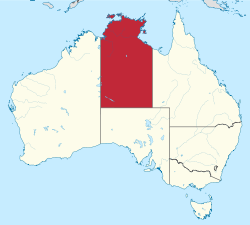
The Ontario Provincial Police (OPP) is the provincial police service for the province of Ontario, Canada. In the late 1940s, policing functions were reorganized in Ontario, with the OPP given responsibility for all law enforcement in the province outside areas covered by municipal police services, together with overall authority for law enforcement on the King's Highways, enforcement of the provincial liquor laws, aiding the local police and maintaining a criminal investigation branch.
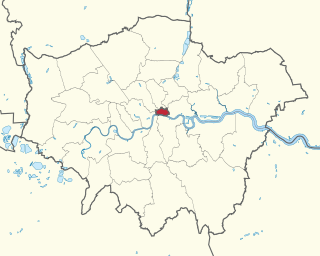
The City of London Police is the territorial police force responsible for law enforcement within the City of London, including the Middle and Inner Temples. The force responsible for law enforcement within the remainder of the London region, outside the City, is the much larger Metropolitan Police Service, a separate organisation. The City of London, which is now primarily a financial business district with a small resident population but a large commuting workforce, is the historic core of London, and has an administrative history distinct from that of the rest of the metropolis, of which its separate police force is one manifestation.

The New South Wales Police Force is the primary law enforcement agency of the state of New South Wales, Australia. Divided into Police Area Commands (PACs), for metropolitan areas and Police Districts (PDs), for regional and country areas, the NSW Police Force consists of more than 400 police stations and over 18,000 officers, who are responsible for covering an area of 801,600 square kilometres and a population of more than 8.2 million people.

Law enforcement in Australia is one of the three major components of the country's justice system, along with courts and corrections. Law enforcement officers are employed by all three levels of government – federal, state/territory, and local.

Victoria Police is the primary law enforcement agency of Victoria, Australia. It was formed in 1853 and currently operates under the Victoria Police Act 2013.

The Queensland Police Service (QPS) is the principal law enforcement agency responsible for policing the Australian state of Queensland. In 1990, the Queensland Police Force was officially renamed the Queensland Police Service and the old motto of "Firmness with Courtesy" was changed to "With Honour We Serve". The headquarters of the Queensland Police Service is located at 200 Roma Street, Brisbane.

The Western Australia Police Force, colloquially WAPOL, provides police services throughout the state of Western Australia, an area of 2.5 million square kilometres, the world's largest non-federated area of jurisdiction, with a population of only 2.474 million, of which 2.14 million reside in the Perth Metropolitan Region.

The South Australia Police (SAPOL) is the police force of the Australian state of South Australia. It is an agency of the Government of South Australia within the South Australian Department of Justice. SAPOL is directed by the Commissioner of Police, who reports to the Minister for Police. As of 30 June 2017, South Australia Police had 4948 active sworn members, including 339 cadets in training and 132 protective services officers, as well as approximately 920 civilian staff operating across 28 metropolitan and 110 regional police stations.
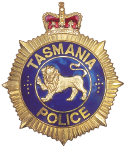
Tasmania Police is the primary law enforcement agency of the Australian state of Tasmania. Established in 1899, the force has more than 1,200 officers policing Tasmania's population of over half a million people.
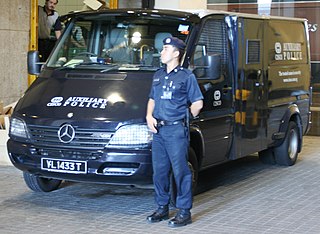
Auxiliary police, also called special police, are usually the part-time reserves of a regular police force. They may be armed or unarmed. They may be unpaid volunteers or paid members of the police service with which they are affiliated. In most jurisdictions, auxiliary police officers are empowered to make arrests for crimes that occur in their presence.

Merseyside Police is the territorial police force responsible for policing Merseyside in North West England. The service area is 647 square kilometres with a population of around 1.5 million. As of September 2017 the service has 3,484 police officers, 1,619 police staff, 253 police community support officers, 155 designated officers and 208 special constables. In terms of officer numbers, the force is the 8th largest of the 48 police forces of the United Kingdom. However, in terms of geographic area of responsibility, it is the 3rd smallest of the territorial police forces after the City of London Police and Cleveland Police. The force is led by Chief Constable Andy Cooke.
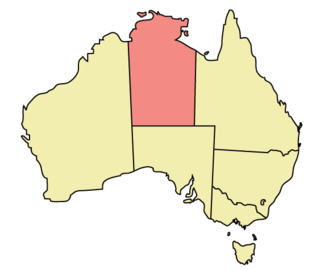
Crime in the Northern Territory is managed by the Northern Territory Police, the territory government's Department of the Attorney-General and Justice and Territory Families.

Essex Police is a territorial police force responsible for policing the county of Essex, in the east of England, consisting of over 1.7 million people and around 1,400 square miles. It is one of the largest non-metropolitan police forces in the United Kingdom, with over 2,900 police officers.

Suffolk Constabulary is the territorial police force responsible for policing Suffolk in East Anglia, England.
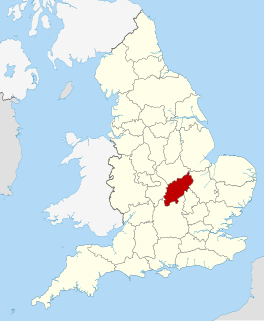
Northamptonshire Police is the territorial police force responsible for policing the county of Northamptonshire in the East Midlands of England, in the United Kingdom.

The Royal Cayman Islands Police Service is the standing police force of the British overseas territory of the Cayman Islands. The police force was formed in 1907 and currently (2009) stands at 343 enlisted officers, with 64 civilians.
Police uniforms and equipment in the United Kingdom have varied considerably from the inception of what were the earliest recognisable mainstream police services in the early 19th century. As various laws in the mid-19th century standardised policing in the United Kingdom, the uniforms and equipment become standardised. From a variety of home grown uniforms, bicycles, swords and pistols the British police force evolved in look and equipment through the long coats and top hat, to the recognisable modern uniform of a white shirt, black tie, reflective jackets, body armour, and the battenburg car, to the present-day Airwave Solutions radios, electric vehicles and tasers.

Northern Territory Fire and Rescue Service, or NTFRS, is the primary provider of fire and rescue services throughout the 1.35 million square km Northern Territory of Australia. It is made up of 27 fire stations, 16 being staffed by volunteer brigade units, 5 being manned 24 hours by career fire fighters, and the remainder by a mix of career and auxiliary fire fighters.
The police in Canada ranks differ according to the different police forces and depend on different laws at the federal, provincial and municipal levels from.

St John Ambulance Northern Territory is a non-profit, charitable organisation providing first aid services and training, urgent care, patient transport, ambulance and other medical services in the Northern Territory. It has served as the primary ambulance service in the Northern Territory since 1966. These services are provided through a combination of paid and volunteer staff. St John NT is funded through a combination of government funding, corporate and private donations and user pays services.


